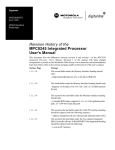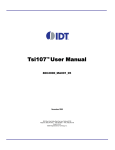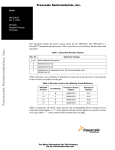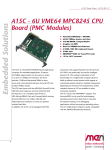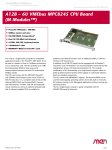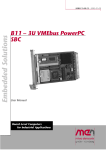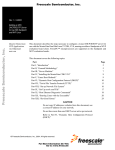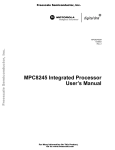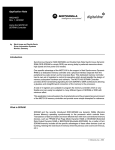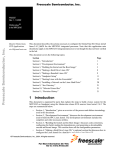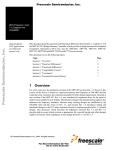Download Errata to the MPC8245 Integrated Processor User`s Manual, Rev. 2
Transcript
Freescale Semiconductor Addendum Document Number: MPC8245R2UMAD Rev. 2.3, 04/2005 Errata to the MPC8245 Integrated Processor User’s Manual, Rev. 2 This errata document describes corrections to the MPC8245 Integrated Processor User’s Manual, Rev. 2. For convenience, errata items refer to the section and page numbers in the user’s manual. Items in bold are new since the last revision of this document. To locate any published updates for this document, refer to the world-wide web at http://freescale.com. 1 Document Revision History Table 1 provides a revision history for this errata addendum. NOTE All errata in this document after that for E.2 on page 10 consist of an appendix section that was omitted from the revision history of the MPC8245 Integrated Processor User’s Manual, Rev. 2. All errata in this document from that point forward had already been corrected in the Rev. 2 manual. . Table 1-1. Document Revision History Revision Number Date 2.1 — Added new errata item for the following section: Appendix E, pages E35-E61 2.2 — Added explanation about the previous user’s manual errata being added to Appendix E 2.3 04/05 Substantive Change Added all errata for revision 2 of the reference manual except for item E.2 on page 10 detailing the omission of the revision history information in Appendix E © Freescale Semiconductor, Inc., 2005. All rights reserved. Section, Page No. 2 Changes Document Errata The following section discusses new errata for the MPC8245 Integrated Processor User’s Manual, Rev. 2. Section, Page Changes Throughout manual Whenever the dcbi instruction is mentioned, it should be accompanied by the following note: NOTE The dcbi instruction should never be used on the G2 core. 2.2.2.17, 2-24 State Meaning 2.2.2.18, 2-25 Timing Comments 2.3.1, 2-40 2.3.2, 2-40 2.4, 2-44 The description for ‘State Meaning’ should be labeled ‘Timing Comments.’ The following ‘State Meaning’ paragraph should be inserted immediately prior: Asserted/Negated: The falling and rising edges of the AS signal provide a latch strobe or edge reference to allow external devices to latch the data, address, or control signals from the memory interface signals. AS is driven active for all accesses to the ROM/Flash address space and the extended ROM/Flash address space. This allows for Port X devices to share the address space with ROM devices. The following ‘Timing Comments’ paragraph should be inserted at the end of the section: Asserted: DRDY may be asserted anytime after a Port X strobe or handshake access has begun, However, if DRDY is not asserted for a Port X handshake transaction or for a period of time greater than the SDRAM refresh interval, the memory may degrade and the memory controller will hang. Negated: DRDY must be negated one clock cycle after RCSn is negated for the Port X transaction. Insert the following sentence after the first sentence of the last paragraph of this section (immediately under the note): PLL_CFG[0:4] signals must be driven on reset and must be held for at least 25 clock cycles after the negation of HRST_CTRL and HRST_CPU in order to be latched. Replace the last two sentences of the last paragraph on this page with the following: For the SDRAM sync loop (SDRAM_SYNC_OUT to SDRAM_SYNC_IN), there is an inherent delay offset (Tos) that must be considered. The feedback trace length of SDRAM_SYNC_OUT to SDRAM_SYNC_IN should be shortened to reduce the impact of Tos. For more details on Tos, please refer to the hardware specifications document. Insert the following sentence immediately before the last sentence of this section: PLL_CFG[0:4] signals must be driven on reset and must be held for at least 25 clock cycles after the negation of HRST_CTRL and HRST_CPU in order to be latched. Errata to the MPC8245 Integrated Processor User’s Manual, Rev. 2 2 Freescale Semiconductor Section, Page No. Changes 2.4, 2-45 In Table 2-5, the state meanings for the MDH signals have been modified to the following: Signal Name Default State Meaning MDH[16:31] x1 Sets the initial value of the PCI Subsystem Vendor ID register (at offset 0x2C). Note that if this signal is not used for identifying a vendor ID, the default value can be used. MDH[0:15] x2 Sets the initial value of the PCI Subsystem ID register (at offset 0x2E). Note that if this signal is not used for identifying a subsystem ID, the default value can be used. 1 The MDH[16:31] signals can be driven at reset to determine the initial value of the PCI Subsystem Vendor ID, but alternatively they can be programmed after initialization. 2 The MDH[0:15] signals can be driven at reset to determine the initial value of the PCI Subsystem ID, but alternatively they can be programmed after initialization. 4.2.2, 4-13 In Table 4-5, “Bit Settings for PCI Status Register—0x06,” the reset value of bit 7, fast back-to-back enable, should be x. Also, the description should state: This bit is hardwired to 1 on silicon revisions 1.2 (B) and earlier, 0 on silicon revision 1.4. Note that, due to errata #20, type 2 fast back-to-back transactions are not supported on the MPC8245. In Table 4-17, the descriptions of PMCR1[CKO_MODE] and PMCR1[CKO_SEL] should read as follows: 4.3.1, 4-20 1 2–1 CKO_MODE 00 Selects the clock source for the test clock output. 00 Disables the test clock output driver. Note that, in this case, there is no clock output on CKO regardless of the setting of CKO_SEL (bit 0). 01 Selects the internal sys_logic_clk signal as the test clock output source 10 Selects one-half of the PCI rate clock as the test clock output source 11 Selects the internal PCI rate clock as the test clock output source 0 CKO_SEL x1 The initial value of this bit is determined by the AS reset configuration bit, which selects either the clock output of the processor core or the clock output of the system logic to be driven out of the CKO signal. 0 Processor core clock selected. The signal driven by CKO is determined by HID0[ECLK,SBCLK]. See Section 1.3.1.2.1, “Hardware Implementation-Dependent Register 0 (HID0),” for the available choices. 1 System logic clock selected. The signal driven by CKO is determined by the encoding of the CKO_MODE bits above. See CKO_MODE field description for the available choices. Note that if CKO_MODE (bits 2–1) are set to 00, there is no clock output on CKO regardless of the setting of this bit. Initial value depends on reset configuration signal. See Section 1.4, “Configuration Signals Sampled at Reset.” 4.4, 4-23 In Table 4-19, the reset value of DRV_PCI_CLK[1–2] (bits 3–2) should be changed from 1 to 11. Also in Table 4-19, the description of bits 1–0 should read: “Controls drive strength of SDRAM_CLK[0:3] and SDRAM_SYNC_OUT for silicon revision 1.2 and later” Errata to the MPC8245 Integrated Processor User’s Manual, Rev. 2 Freescale Semiconductor 3 Section, Page No. Changes 4.7, 4-34 In Table 4-31, “Bit Settings for PICR2—0xAC,” bit 0 is no longer reserved; the bit name is CB_OPT. The affected rows of the table should read as follows: Bits Name Reset Value 1 — 0 Reserved 0 CB_OPT 0 AC[0]—Copyback optimization 0 CCU can start the speculative read (or prefetch) of the next cache line (for PCI read streaming purposes), even if the copyback buffer has valid data 1 CCU will not start the speculative read (or prefetch) of the next cache line (for PCI read streaming purposes), until the copyback buffer is invalidated 4.8.2, 4-39 Description In Table 4-37, “Bit Settings for Error Enabling Register 2 (ErrENR2)—0xC4,” bit 6 is no longer reserved; the bit name is PCI SERR enable. (This change applies only to silicon revision 1.4.) The affected rows of the table should read as follows: Bits Name Reset Value 6 PCI SERR enable 0 Functional only in silicon revision 1.4. This bit enables the reporting of SERR assertions that occur on the PCI bus at any time regardless of whether the MPC8245 is the initiator, the target, or a non-participating agent. 0 SERR detection is disabled 1 SERR detection is enabled 5–4 — 00 Reserved 4.8.2, 4-40 Description In Table 4-38, “Bit Settings for Error Detection Register 2 (ErrDR2)—0xC5,” bit 6 is no longer reserved; the bit name is PCI SERR error. (This change applies only to silicon revision 1.4.) The affected rows of the table should read as follows: Bits Name Reset Value 6 PCI SERR error 0 Functional only in silicon revision 1.4. This bit indicates the assertion of SERR by an external PCI agent regardless of whether the MPC8245 is the initiator, the target, or a non-participating agent. 0 SERR not detected 1 SERR detected 5–4 — 00 Reserved Description Errata to the MPC8245 Integrated Processor User’s Manual, Rev. 2 4 Freescale Semiconductor Section, Page No. Changes 4.9, 4-44 In Table 4-41, “Extended ROM Configuration Register 1—0xD0,” the description of bits 9–5 (RCS2_ASRISE) should read as follows: Bits Name Reset Value 9–5 RCS2_ASRISE All 0s 9–5 RCS2 AS rise time.These bits control how long AS is held asserted, or when the AS signal is negated relative to the assertion of AS for the Port X interface. See Section 1.3.5, “Port X Interface,” for more information. 00000 Disables AS signal generation 00001 1 clock 00010 2 clocks 00011 3 clocks ... 11111 31 clocks Also in Table 4-41, the description column of row ‘RCS2_TS_WAIT_TIMER’ should be modified as follows: A note should be added to the table entitled ‘Wait States for ROM High Impedance.’ The note applies to the columns ‘Reads with gather data path in registered buffer mode (8, 16, 32-bit)’ and ‘All Flash writes 1,2 and reads with gather data path in inline buffer mode (8, 16, 32,-bit),’ and should read as follows: Note that TS_WAIT_TIMER only applies to gather data path reads when using independent or base timing (RCS2_CTL = 0n); TS_WAIT_TIMER has no effect on gather data path reads in Port X strobe or handshake modes (RCS2_CTL = 1n). In Table 4-42, “Extended ROM Configuration Register 2—0xD4,” the description of bits 9–5 (RCS3_ASRISE) should read as follows: 4.9, 4-47 Bits Description Reset Value Name RCS3_ASRISE All 0s Description RCS3 AS rise time.These bits control how long AS is held asserted, or when the AS signal is negated relative to the assertion of AS for the Port X interface. See Section 1.3.5, “Port X Interface,” for more information. 00000 Disables AS signal generation 00001 1 clock 00010 2 clocks 00011 3 clocks ... 11111 31 clocks Also in Table 4-42, the description column of row ‘RCS3_TS_WAIT_TIMER’ should be modified as follows: A note should be added to the table entitled ‘Wait States for ROM High Impedance.’ The note applies to the columns ‘Reads with gather data path in registered buffer mode (8, 16, 32-bit)’ and ‘All Flash writes 1,2 and reads with gather data path in inline buffer mode (8, 16, 32,-bit),’ and should read as follows: Note that TS_WAIT_TIMER only applies to gather data path reads when using independent or base timing (RCS3_CTL = 0n); TS_WAIT_TIMER has no effect on gather data path reads in Port X strobe or handshake modes (RCS3_CTL = 1n). Errata to the MPC8245 Integrated Processor User’s Manual, Rev. 2 Freescale Semiconductor 5 Section, Page No. Changes 4.10, 4-51 In Table 4-45, “Bit Settings for the AMBOR—0xE0,” the description of DLL_RESET (bit 5) should read as follows: Bits Name Reset Value 5 DLL_RESET 0 Description Used to reset the DLL tap point. See Section 1.3.2, “DLL Operation and Locking.” This bit must be explicitly set and then cleared by software during initialization in order to guarantee correct operation of the DLL and the SDRAM_CLK[0:3] signals (if they are used). The toggling of this bit needs to occur after the DLL mode has been chosen using bit 7 of 0x72 and bit 2 of 0x76. See the hardware specification document for more details on the DLL locking modes and their related graphs. 0 DLL tries to lock the phase between the SDRAM_SYNC_IN signal and the internal sys_logic_clk signal. 1 The SDRAM_CLK signals are driven from tap point 0 of the internal delay line. Also in Table 4-45, bit 0 is no longer reserved; the bit name is PCMWB_OPT. The affected rows of the table should read as follows: Bits Name Reset Value 1 — 0 Reserved 0 PCMWB_OPT 0 E0[0]—PCMWB optimization—1 0 CCU can start the speculative read (or prefetch) of the next cache line (for PCI read streaming purposes), even if any PCMWBs have valid data 1 CCU will not start the speculative read (or prefetch) of the next cache line (for PCI read streaming purposes), until all PCMWBs are invalidated 4.13, 4-53 5.4.3.1, 5-26 6.2.9, 6-28 6.3.4, 6-62 Description The register at offset 0xE3 should be called the DLL tap count register (DTCR). The title of Table 4-48 should be: ‘Bit Settings for the DTCR—0xE3.’ In Table 4-48, “Bit Settings for this Register—0xE3,” add the following sentence to the end of the description for DLL_TAP_COUNT (bits 6–0): See Section 6 of AN2164, MPC8245/MPC8241 Memory Clock Design Guidelines: Part 1, for details on the use of these bits. In Table 5.5, the row listing eieio should be deleted. Insert the following sentence after the first sentence of paragraph 2 (beginning with the words “Because RMW parity assumes....”): RWM parity is not supported when in 32-bit data path mode. Replace the last paragraph immediately before Section 6.3.4.1 (paragraph begins with ‘TS_WAIT_TIMER represents wait states....’) with the following: TS_WAIT_TIMER represents wait states in the recovery time for certain ROM accesses. Some ROM/Flash/Port X devices require long output disable timing. To avoid contention, TS_WAIT_TIMER can be used to delay a subsequent data transaction start on the local memory bus to allow the slow device to stop driving the data bus. The delay is enforced for all local memory accesses (SDRAM or ROM) that require a data tenure after most accesses to ROM space. The default Errata to the MPC8245 Integrated Processor User’s Manual, Rev. 2 6 Freescale Semiconductor Section, Page No. 6.3.5.2, 6-70 6.3.5.4, 6-71 6.3.5.4, 6-72 7.1, 7-2 7.7.4, 7-37 Changes number of wait states is 2 clocks. TS_WAIT_TIMER applies under the following conditions: • If the ROM has a wide data bus (that is, 64-/32-bit, non-gathered), TS_WAIT_TIMER applies to all read/write transactions. • If the ROM has a narrow data bus (that is, 8-/16-/32-bit, gathered data path), TS_WAIT_TIMER applies to all write transactions. However, for read transactions, TS_WAIT_TIMER applies only when using the independent or base timing modes (RCSn_CTL = 0n); TS_WAIT_TIMER has no effect following reads in Port X strobe and handshake modes (RCSn_CTL = 1n). • Regardless of the data bus width, TS_WAIT_TIMER only holds off subsequent transactions that require a data tenure. SDRAM address-only or command cycles such as bank-activate or refresh do not wait for TS_WAIT_TIMER to expire. The title of Figure 6-47 should be Port X 8-Bit Read Access Timing. Replace the second sentence of the second paragraph (paragraph begins with the words ‘In Port X handshake mode, ....’) with the following: While RCSn is held asserted until DRDY is asserted, AS is negated 4 clocks after DRDY is asserted or when RCSn_ASRISE is exceeded, whichever occurs first. Replace the first sentence of the first paragraph after Figure 6-50 (begins with the words ‘ASFALL is the only relevant timing parameter....’) with the following: ASFALL and ASRISE are the relevant timing parameters in Port X handshake mode; the ROMFAL parameter is ignored. Note that the assertion of DRDY may terminate AS assertion earlier than the ASRISE interval. In the third paragraph after the note (paragraph begins with the words ‘The MPC8245 also provides ....’), replace the third sentence with the following: Host mode supports only outbound address translation. Replace the second sentence of the paragraph with the following: Inbound and outbound address translation are both supported in agent mode; however, in host mode, only outbound address translation is supported. Errata to the MPC8245 Integrated Processor User’s Manual, Rev. 2 Freescale Semiconductor 7 Section, Page No. Changes In Figure 10-8, “Example I2C Interrupt Service Routine Flowchart,” replace the two occurrences of I2CCR[MAL] with I2CSR[MAL]. The figure should look as follows: 10.4.8, 10-19 Clear I2CSR[MIF] == 1 I2CCR[MTX] A == 1 Master Xmit Y == 1 Last byte I2CSR[RXAK] == 0 End of address phase for master receive mode? N Y Write next byte to I2CDR Y Only one byte to receive? Clear I2CCR[TXAK] I2CSR[MAL] N Clear I2CSR[MAL] == 1 Generate STOP == 0 == 0 I2CCR[MSTA] N Set I2CCR[TXAK] I2CSR[MAAS] == 0 == 0 I2CSR[MAAS] == 1 == 1 B == 0 B EOI Slave Data Cycle Slave Xmit == 1 == 1 I2CCR[MTX] == 0 Slave Received I2CSR[RXAK] Read I2CDR and store == 0 Clear I2CCR[MTX] N Clear I2CCR[MTX] Read I2CDR (dummy read) Write next byte to I2CDR Read I2CDR (dummy read) Set I2CCR[TXAK] EOI EOI A Master Rcv All done Y N B Y Last byte Y Next-to-last N byte Slave Addr. Phase == 1 Generate STOP Set I2CCR[TXAK] I2CSR[SRW] Set I2CCR[MTX] == 0 Clear I2CCR[MTX] Dummy read Write I2CDR Read I2CDR and store EOI EOI Figure 10-8. Example I2C Interrupt Service Routine Errata to the MPC8245 Integrated Processor User’s Manual, Rev. 2 8 Freescale Semiconductor Section, Page No. Changes 12.4.9, 12-23 In Table 12-15, change the last sentence in the description for the BI field (bit 4) to read: Note that for the non-FIFO mode, after the ULSR is read, ULSR[BI] is immediately set if the bus remains zero and no mark state followed by a valid new character has been detected. In Table 16-3, “Monitor Mode Control Register (MMCR)” change the description of bits 6 and 0 as follows: 16.2.2, 16-4 Bits Name 6 DISCOUNT 5–1 — 0 PMCTRIG Reset Value R/W 1’b0 Description RW Disable counter for msb bit. This bit determines the counting behavior of all counters when any counter reaches a negative value (most significant bit is set). 0 No effect on the counters 1 All the counters are disabled if any of PMC0–PMC3 has bit 31 set and MMCR[PMCTRG] = 0 Reserved 1’b0 RW Performance monitor counter trigger. This bit determines the behavior of all counters if any reach a negative value (most significant bit is set). 0 No effect on counters if MMCR[DISCOUNT] is clear; otherwise see description MMCR[DISCOUNT] for expectations if it is set and this bit is clear. 1 Counting of PMC1, PMC2, and PMC3 will begin only when msb of any PMC0–PMC3 are set and stop when msb of all PMC0–PMC3 are cleared. PMCTRG may be used as a triggering mechanism (use PMC0 to define the triggering event) to allow counting after a certain condition occurs or after enough time has elapsed. Note that because all the counters are writable, when this bit is set, if the msb of any of the counters are written to, all the remaining counters begin counting. Incrementing of the counters will continue until the last of all the counters have a positive value. Errata to the MPC8245 Integrated Processor User’s Manual, Rev. 2 Freescale Semiconductor 9 Section, Page No. Changes NOTE The following erratum contains an appendix section that was omitted from the revision history of the MPC8245 Integrated Processor User’s Manual, Rev. 2. It contains only errata that had already been corrected in the Rev. 2 manual. E.2, E-35 E.2 Add new section E.2 with the following text that details the revision history from Rev. 0 to Rev. 1 of the user’s manual. (This section was omitted from Rev. 2.0 of the user’s manual.) Revision Changes From Revision 0 to Revision 1 Major changes to the MPC8245 Integrated Processor User’s Manual from Revision 0 to Revision 1 are as follows: Section, Page 1.1.1, 1-4 Changes The second bullet under the Memory Interface heading should state: – High-bandwidth data bus (32- or 64-bit) to SDRAM The fourth bullet under the Memory Interface heading should state: – Supports 1 to 8 banks of 16-, 64-, 128-, 256-, or 512-Mbit memory devices The second to the last bullet under the Memory Interface heading should state: – Extended ROM space supports 8-, 16-, or 32-bit gathering data path, 32- or 64-bit (wide) data path The second to the last bullet under the 32-bit PCI interface heading should be replaced with the following sentence: – Address translation with two inbound and outbound units (ATU) The second to the last bullet under the Two-channel Integrated DMA Controller (Writes To ROM/PORTX Not Supported) heading should be replaced with the following: – Local-to-PCI memory The following statement should be added to the list of Debug Features: – Error injection/capture on data path Sections that describe signals SDMA13 and SDMA14 have been added to this chapter: 1.1.1, 1-4 1.1.1, 1-4 1.1.1, 1-4 1.1.1, 1-5 1.1.1, 1-5 2.1.1, 2-6 Signal Signal Name Interface … … … SDMA13 SDRAM address 13 Memory SDMA14 SDRAM address 14 Memory … … … Alternate Function(s) Pins I/O Section # … … … … See Table 6-2 1 O 2.2.2.a 1 O 2.2.2.b … … … … Errata to the MPC8245 Integrated Processor User’s Manual, Rev. 2 10 Freescale Semiconductor Section, Page No. Changes 2.1.2, 2-7 In Table 2-2, Signals SDMA12/SRESET, SDMA12/TBEN, SDMA14/CHKSTOP_IN are driven if extended addressing mode is enabled. 2.2.2.4 and 2.2.2.5, 2-18 The last sentence of the state meanings for SDRAM Address (SDMA[11:0]) and SDRAM Address 12 (SDMA12) should state: See Section 6.2.2, “SDRAM Address Multiplexing,” Section 6.3.1.1, “Base ROM Address Multiplexing,” and Section 6.3.2.1, “Extended ROM Address Multiplexing,” for a complete description of the mapping of these signals in all cases. 2.2.2.5, 2-18 The following sentence should be added to the first paragraph of this section: “SDMA12 is used in extended addressing mode. See Section 6.2.2, “SDRAM Address Multiplexing” and Section 2.4, “Configuration Signals Sampled at Reset,” for more information.” 2.2.2.6, 2-18 The following signal descriptions of SDMA13 and SDMA14 should be added to this chapter after the SDMA12 description: 2.2.2.a SDRAM Address 13 (SDMA13)—Output The SDMA13 signal is similar to SDMA[11:0] in that it corresponds to different row or column address bits, depending on the memory in use. SDMA13 is multiplexed with TBEN and is used in extended addressing mode. See Section 6.3.2, “Extended ROM Interface,” for more information. State Meaning Asserted/Negated: See Section 6.3.2.1, “Extended ROM Address Multiplexing,” for a complete description of the mapping of this signal in all cases. Timing Comments Assertion/Negation: The same as SDMA[11:0]. 2.2.2.b SDRAM Address 14 (SDMA14)—Output The SDMA14 signal is similar to SDMA[11:0] in that it corresponds to different row or column address bits, depending on the memory in use. SDMA14 is multiplexed with CHKSTOP_IN and is used in extended addressing mode. See Section 6.3.2, “Extended ROM Interface,” for more information. State Meaning Asserted/Negated: See Section 6.3.2.1, “Extended ROM Address Multiplexing,” for a complete description of the mapping of this signal in all cases. Timing Comments Assertion/Negation: The same as SDMA[11:0]. 2.2.5, 2-25 The following sentences should be added to the first paragraph of this section: “The signals SIN1, SOUT1, SIN2/CTS1, and SOUT2/RTS1 are multiplexed with PCI_CLK0, PCI_CLK1, PCI_CLK2, and PCI_CLK3, respectively. Note that when using DUART signals, PCI_CLK[0:3] signals cannot be used.” Errata to the MPC8245 Integrated Processor User’s Manual, Rev. 2 Freescale Semiconductor 11 Section, Page No. 2.2.6.2, 2-27 2.2.6.3, 2-27 2.2.6.3, 2-28 2.2.6.6, 2-28 2.2.6.7, 2-29 2.2.8.2, 2-34 2.3.2, 2-37 Changes The last sentence of the first paragraph of this section should be replaced with the following: “Note that the SRESET signal is multiplexed with the SDMA12 signal. In extended addressing mode, SDMA12 is used and SRESET is not available. See Section 6.3.2, “Extended ROM Interface,” for more information.” The following sentence should be added to the first paragraph of this section: “Note that the output driver for MCP can be designated as open-drain by setting the MIOCR[MCP_OD_MODE] parameter.” PMCR2[SHARED_MCP] should be replaced with MIOCR[MCP_OD_MODE] in the last paragraph of this section as follows: “High impedance: If the MIOCR[MCP_OD_MODE] bit is set, the MCP signal is placed in high impedance when there is no error to report.” The following sentences should be added to the first paragraph of this section: “Note that the CHKSTOP_IN signal is multiplexed with the SDMA14 signal. In extended addressing mode, SDMA14 is used and CHKSTOP_IN is not available. See Section 6.3.2, “Extended ROM Interface,” for more information.” The first paragraph should state: “Following are the state meaning and timing comments for TBEN. Note that the TBEN signal is multiplexed with the SDMA13 signal. In extended addressing mode, SDMA13 is used and TBEN is not available. In this case, PICR1[DEC] can be used to enable the processor core’s decrementer. See Table 4-31 for a description of PICR1[DEC].” The following sentence should be added to this section: “Note that PCI_CLK[0:3] cannot be used when using DUART signals SIN1, SOUT1, SIN2/CTS1, and SOUT2/RTS1.” The fourth paragraph of this section should state: “In order to insure proper operation and successful locking of the DLL, there are certain requirements that must be met as described in the MPC8245 Hardware Specification. In some cases (depending on the board layout and the frequencies), the DLL lock range must be lengthened by setting the MIOCR1[DLL_MAX_DELAY] bit described in Section 4.5, “Output/Clock Driver and Miscellaneous I/O Control Registers.” This is accomplished by increasing the time between each of the 128 tap points in the delay line. Although this increased time makes it easier to guarantee that the reference clock is within the DLL lock range, it also means there may be slightly more jitter in the output clock of the DLL, should the phase comparator shift the clock between adjacent tap points. ” Errata to the MPC8245 Integrated Processor User’s Manual, Rev. 2 12 Freescale Semiconductor Section, Page No. Changes 2.4, 2-40 In Table 2-5, the state meaning of signal MAA0 should be as follows: Signal Name Default … … … MAA0 1 Address map setting. This signal should always be pulled high since the MPC8245 only supports address map B. 1 The MPC8245 is configured for address map B. … … … 2.4, 2-41 State Meaning In Table 2-5, the default value of signal PMAA2 is 0, as follows: Signal Name Default … … … PMAA2 0 Driver capability for the PCI and EPIC controller output signals. The value of this signal sets the initial value of ODCR[DRV_PCI]. 0 40 Ω drive capability on PCI/EPIC signals 1 20 Ω drive capability on AD[31:0], C/BE[3:0], DEVSEL, FRAME, GNT[4:0], PAR, INTA, IRDY, PERR, SERR, STOP, TRDY, IRQ0/S_INT, IRQ1/S_CLK, and IRQ4/L_INT signals and 6 Ω drive capability on IRQ2/S_RST and IRQ3/S_FRAME … … … 2.4, 2-41 State Meaning In Table 2-5, the second sentence of the SDMA1 state meaning should state the following: Signal Name Default State Meaning … … … SDMA1 1 Extended addressing mode. When this signal is low during reset, the extended addressing mode is enabled. The value of this signal during reset determines the function of the SRESET, TBEN, CHKSTOP_IN, TRIG_IN, and TRIG_OUT signals. See 6.3.2, “Extended ROM Interface,” for more information on the multiplexing of these signals. 0 Extended addressing mode enabled. SDMA12, SDMA13, SDMA14, RCS2, and RCS3 signals are available. 1 Extended addressing mode disabled. SRESET, TBEN, CHKSTOP_IN, TRIG_IN, and TRIG_OUT are available. … … … In Table 3-2, PCI memory transaction address range 7000_0000–7FFF_FFFF has a local memory address range of 7000_0000–7FFF_FFFF as follows: 3.1, 3-2 PCI Memory Transaction Address Range Hex … Decimal … … … Local Memory Address Range … Definition … Errata to the MPC8245 Integrated Processor User’s Manual, Rev. 2 Freescale Semiconductor 13 Section, Page No. Changes PCI Memory Transaction Address Range Hex Local Memory Address Range Decimal Definition 7000_0000 7FFF_FFFF 2G - 256M 2G - 1 7000_0000–7FFF_FFFF … … … … … 3.1, 3-4 Extended ROM/Flash (256 MBytes)11 … In Figure 3-1, the memory controller range between 2GB and 4GB – 32MB should state “Forwards to PCI memory space,” as follows: MPC8245 Memory Controller Processor 0 Local memory space 0 to 2GB - 256MB Local memory Not forwarded to PCI bus. Memory controller performs local memory access Reserved PCI Memory Space 0 Not addressable by processor 2GB - 256MB Extended ROM Extended ROM 2GB Forwards to PCI Memory Space PCI memory space in range 2 to 4GB - 32MB Not addressable by processor 2GB 4GB - 32MB 4GB - 16MB If local ROM, not addressable as PCI memory. If remote ROM, PCI memory space PCI Memory Space 4GB PCI I/O Space 4GB - 32MB PCI I/O Space 4GB - 32MB + 64KB Clears A[31:24] and forwards to PCI I/O space, except 0xFE01_0000– 4GB - 24MB 0xFE7F_FFFF, which is reserved PCI I/O Space CONFIG_ADDR CONFIG_DATA PCI Int Ack ROM or Flash 0 I/O addresses in 0 to 64KB range 64KB 8MB I/O addresses in 8MB to 12MB range 4GB - 20MB 4GB - 18MB 4GB - 17MB 4GB - 16MB 4GB 12MB PCI Configuration Access Int Ack Broadcast PCI Not addressable by processor ROM Access 4GB Errata to the MPC8245 Integrated Processor User’s Manual, Rev. 2 14 Freescale Semiconductor Section, Page No. 3.1, 3-6 Changes Replace Figure 3-3 with the following: PCI Master I/O Space MPC8245 Memory Controller 0 Addressable by processor 64KB Reserved 8MB Addressable by processor 12MB MPC8245 does not respond as a target to PCI I/O accesses Not addressable by processor 4GB Figure 3-3. PCI I/O Master Address Map B Errata to the MPC8245 Integrated Processor User’s Manual, Rev. 2 Freescale Semiconductor 15 Section, Page No. Changes 3.4.1, 3-26 The cross reference to the performance monitor section should be added to Table 3-13 as follows: Local Memory Offset Register Set … … Reference … 0xF_E000 – 0xF_EFFF Performance monitor Section 16.2.3, “Performance Monitor Counter (PMC0–PMC3)” … … 3.4.2, 3-27 The cross reference to the performance monitor section should be added to Table 3-14 as follows: PCI Memory Offset Register Set … … 0xE00 – 0xEFF Performance monitor … … Chapter 4 … 0xDC … Section 16.2.3, “Performance Monitor Counter (PMC0–PMC3)” … Program Access (Bytes) … … … … … Extended ROM configuration register 3 4 4 Read/Write 0x0C00_000E Register Access Reset Value Extended ROM configuration register 4 4 4 Read/Write 0x0800_000E … … … … … 4.2.8, 4-15 The description of this register in Table 4-12 should read as follows: Bits Reset Value msb 15–0 x1 Description Value is determined at startup through configuration pins MDH[16:31] but can be programmed by software after reset. Initial value depends on reset configuration signal. See Section 2.4, “Configuration Signals Sampled at Reset.” 4.2.9, 4-15 1 … Size (Bytes) Address Offset 0xD8 Reference The correct Performance Monitor Command Registers are the 4 CMDR registers (CMDR0-CMDR3) referenced in Section 16.2. The Performance Monitor Command Registers at 0x48 through 0x5C should not be used. Any reference to these registers have been removed from this chapter. In Table 4-1, offsets 0xD8 and 0xDC should have reset values of 0x0C00_000E and 0x0800_000E, respectively. 4.1.3.1, 4-6 1 … Table 4-13 should be titled “Table 4-13. Subsystem ID—0x2E and the description of this register should read as follows: Bits Reset Value msb 15–0 x1 Description Value is determined at startup through configuration pins MDH[0:15] but can be programmed by software after reset. Initial value depends on reset configuration signal. See Section 2.4, “Configuration Signals Sampled at Reset.” Errata to the MPC8245 Integrated Processor User’s Manual, Rev. 2 16 Freescale Semiconductor Section, Page No. Changes 4.2.11, 4-16 Table 4-15 should contain the following description for bit 5 of the PGCR: Bits Reset Value … … … 5 0 R/W … … … 4.4.2, 4-23 R/W Description … Controls ability to retry all incoming PCI read transactions to local memory while the processor core is writing data to the PCI bus (for example, while internal buffers have data to be written to the PCI bus). 0 Disables ability to retry all incoming PCI memory read transactions to local memory while the processor core is writing data to the PCI bus. 1 Enables ability to retry all incoming PCI memory read transactions to local memory while the processor core is writing data to the PCI bus. … In figure 4-9, PCI_HOLD_DELAY[0-1] should include bits 5-4 as follows: Reserved PLL_SLEEP PCI_HOLD_DELAY[0–1] DLL_EXTEND 0 7 4.4.2, 4-23 1 6 0 5 4 3 00 2 1 0 Bits 6-4 of power management configuration register 2 should be updated as follows: Bits Reset Value R/W Description … … … … Reserved 6 — 0 5–4 PCI_HOLD_DEL xx1 PCI output hold delay value relative to the PCI_SYNC_IN signal. See the MPC8245 Hardware Specification for the detailed number of nanoseconds guaranteed for each setting. There are eight sequential settings for this value; each corresponds to a set increase in hold time: 00 Recommended for 66 MHz PCI bus (default) 01 10 Recommended for 33 MHz PCI bus 11 The initial values of bits 5 and 4 are determined by the inverse of MCP and CKE reset configuration signals, respectively. See Section 2.4, “Configuration Signals Sampled at Reset,” for more information. As these two pins have internal pull-up resistors, the default value after reset is 0b00. … … … … Initial value depends on reset configuration signal. See Section 2.4, “Configuration Signals Sampled at Reset.” 4.5, 4-24 and 4-25 Table 4-21 should be updated as follows: Bit 6 of the output driver control register has been renamed DRV_STD_MEM. Bits 5-4, DRV_MEM_CTRL[1-2], only drive SDRAM_CLK[0:3] and SDRAM_SYNC_OUT signals for silicon revision 1.1. Errata to the MPC8245 Integrated Processor User’s Manual, Rev. 2 Freescale Semiconductor 17 Section, Page No. Changes Bits 1-0, DRV_MEM_CLK[1-2], should be added to the table. Please note these changes in the table below: 1 Bits Name Reset Value msb 7 addr<73> DRV_PCI x1 Driver capability for the PCI and EPIC controller output signals. 0 40 Ω drive capability on PCI/EPIC signals 1 20 Ω drive capability on AD[31:0], C/BE[3:0], DEVSEL, FRAME, GNT[4:0], PAR, INTA, IRDY, PERR, SERR, STOP, TRDY, IRQ0/S_INT, IRQ1/S_CLK, and IRQ4/L_IN signals and 6 Ω drive capability on IRQ2/S_RST and IRQ3/S_FRAME The initial value of this bit is determined by the PMAA2 reset configuration pin. 6 DRV_STD_MEM 1 Driver capability for standard and memory signals (PMAA[0:2], SDA, SCL, CKO, QACK, DA[10:6], MCP, MDH[0:31], MDL[0:31], PAR[0:7], and MAA[0:2]) 0 40 Ω drive capability on standard signals 1 20 Ω drive capability on standard signals 5–4 DRV_MEM_CTRL[1–2] xx1 3–2 DRV_PCI_CLK[1–2] 1 Controls drive strength of PCI_CLK[0:4] and PCI_CLK_SYNC_OUT. DRV_PCI_CLK[1–2]: 00 reserved 01 40-Ω drive capability 10 20-Ω drive capability 11 6-Ω drive capability 1–0 DRV_MEM_CLK_[1–2] 11 Controls drive strength of SDRAM_CLK[0:3] and SDRAM_SYNC_OUT for silicon revision 1.2 DRV_MEM_CLK_[1–2]: 00 reserved 01 40-Ω drive capability 10 20-Ω drive capability 11 6-Ω drive capability Description Driver capability for the memory signals (CS[0:7], DQM[0:7], WE, FOE, RCS0, RCS1, SDBA[1:0], SDRAS, SDCAS, CKE, AS, and SDMA[11:0], CHKSTOP_IN, SRESET, TBEN,TRIG_OUT. Controls drive strength of SDRAM_CLK[0:3] and SDRAM_SYNC_OUT for silicon revision 1.1 DRV_MEM_CTRL[1–2]: 00 reserved 01 40-Ω drive capability 10 20-Ω drive capability 11 6-Ω drive capability The initial value of DRV_MEM_CTRL[1–2] is determined by the PMAA0 and PMAA1 reset configuration pins, respectively. See Initial value depends on reset configuration signal. See Section 2.4, “Configuration Signals Sampled at Reset.” 4.5, 4-25 In Table 4-22, the description for bit 15 should state that it disables/enables the PCI_SYNC_OUT signal of the MPC8245 as follows: Bits Name Reset Value 15 addr<75> PCI_SYNC_OUT 0 Description This bit disables/enables the PCI_SYNC_OUT signal of the MPC8245. A value of one (0b1) disables the output. A value of zero (0b0) enables the output. Errata to the MPC8245 Integrated Processor User’s Manual, Rev. 2 18 Freescale Semiconductor Section, Page No. Changes 4.5, 4-26 In Table 4-23, bit 5 of MIOCR1 should be reserved. Also note that the description of MIOCR1[DLL_MAX_DELAY] should be added as follows: Bits Name Reset Value … … … 5–3 — 000 2 DLL_MAX_DELAY 0 This bit can be used to set the delay line length. Please see Section 2.3.2, “DLL Operation and Locking,” for more information. 0 shorter (or normal) DLL delay line length 1 DLL_max_mode, longer DLL delay line length … … … … 4.7.1, 4-27 Description … Reserved The extended starting and ending address fields have three bits as shown below. The section originally showed these fields as two bits. The correct formulas for the lower and upper boundaries are as follows: Lower boundary for bank n = 0b0 || <extended starting address n> || <starting address n> || 0x0_0000. and Upper boundary for bank n = 0b0 || <extended ending address n> || <ending address n> || 0xF_FFFF. 4.7.1, 4-28 The correct figures for the extended memory starting address registers are as follows: Reserved Extended Starting Address 1 Extended Starting Address 2 Extended Starting Address 3 0000_0 31 Extended Starting Address 0 0000_0 27 26 24 23 0000_0 19 18 16 15 0000_0 11 10 8 7 3 2 0 Figure 4-12. Extended Memory Starting Address Register 1—0x88. Reserved Extended Starting Address 6 Extended Starting Address 5 Extended Starting Address 7 0000_0 31 Extended Starting Address 4 0000_0 27 26 24 23 0000_0 19 18 16 15 0000_0 11 10 8 7 3 2 0 Figure 4-13. Extended Memory Starting Address Register 2—0x8C Errata to the MPC8245 Integrated Processor User’s Manual, Rev. 2 Freescale Semiconductor 19 Section, Page No. 4.7.1, 4-29 Changes The correct bit settings for extended memory starting address registers 1 and 2 are shown in table 4-27 as follows: Bits Name Reset Value 31–27 — All 0s Reserved 26–24 Extended starting address 3 All 0s Extended starting address for bank 3 23–19 — All 0s Reserved 18–16 Extended starting address 2 All 0s Extended starting address for bank 2 15–11 — All 0s Reserved 10–8 Extended starting address 1 All 0s Extended starting address for bank 1 7–3 — All 0s Reserved 2–0 Extended starting address 0 All 0s Extended starting address for bank 0 31–27 — All 0s Reserved 26–24 Extended starting address 7 All 0s Extended starting address for bank 7 23–19 — All 0s Reserved 18–16 Extended starting address 6 All 0s Extended starting address for bank 6 15–11 — All 0s Reserved 10–8 Extended starting address 5 All 0s Extended starting address for bank 5 7–3 — All 0s Reserved 2–0 Extended starting address 4 All 0s Extended starting address for bank 4 4.7.1, 4-30 Description Byte Address 0x88 0x8C The correct figures for the extended memory ending address registers are as follows: Reserved Extended Ending Address 2 Extended Starting Address 1 Extended Ending Address 3 Extended Ending Address 0 0000_0 31 0000_0 27 26 24 23 0000_0 19 18 16 15 0000_0 11 10 8 7 3 2 0 Figure 4-16. Extended Memory Ending Address Register 1—0x98 Reserved Extended Ending Address 6 Extended Starting Address 5 Extended Ending Address 7 0000_0 31 Extended Ending Address 4 0000_0 27 26 24 23 0000_0 19 18 16 15 0000_0 11 10 8 7 3 2 0 Figure 4.17. Extended Memory Ending Address Register 2—0x9C Errata to the MPC8245 Integrated Processor User’s Manual, Rev. 2 20 Freescale Semiconductor Section, Page No. Changes 4.7.1, 4-30 and 4-31 The correct bit settings for extended memory ending address registers 1 and 2 are shown in table 4-29 as follows: Bits Name Reset Value 31–27 — All 0s Reserved Description Byte Address 26–24 Extended ending address 3 All 0s Extended ending address for bank 3 23–19 — All 0s Reserved 18–16 Extended ending address 2 All 0s Extended ending address for bank 2 15–11 — All 0s Reserved 10–8 Extended ending address 1 All 0s Extended ending address for bank 1 7–3 — All 0s Reserved 2–0 Extended ending address 0 All 0s Extended ending address for bank 0 31–27 — All 0s Reserved 26–24 Extended ending address 7 All 0s Extended ending address for bank 7 23–19 — All 0s Reserved 18–16 Extended ending address 6 All 0s Extended ending address for bank 6 15–11 — All 0s Reserved 10–8 Extended ending address 5 All 0s Extended ending address for bank 5 7–3 — All 0s Reserved 2–0 Extended ending address 4 All 0s Extended ending address for bank 4 4.8, 4-33 0x98 0x9C Figure 4-20 should include DEC, bit 8, as follows: Reserved Speculative PCI Reads CF_APARK 0b1 LE_MODE ST_GATH_EN DEC CF_DPARK MCP_EN FLASH_WR_EN PROC_TYPE RCS0 0b00 1111_1111 31 0 0 24 23 22 21 20 19 18 17 16 15 000 0 13 12 11 10 9 0 8 7 1 6 5 4 0 3 2 1 0 Figure 4-20. Processor Interface Configuration Register 1 (PIRC1)—0xA8 Errata to the MPC8245 Integrated Processor User’s Manual, Rev. 2 Freescale Semiconductor 21 Section, Page No. Changes 4.8, 4-34 Table 4-32 should include a description of DEC as follows: Bits Name Reset Value … … … … 8 DEC 0 This bit can be used to enable the time base and decrementor of the processor core. In extended addressing mode, the TBEN signal functions as SDMA13. This bit can be used by software to enable the time base and decrementor in the processor core. 0 Disable processor core decrementer in extended addressing mode 1 Enable processor core decrementer in extended addressing mode … … … … 4.9.2, 4-43 Description In Table 4-40, the reference to MPC107 in the description of PCI SERR error should be replaced with a reference to the MPC8245, as follows: Bits Name Reset Value Description … … … … 6 PCI SERR error 0 This bit indicates the assertion of SERR by an external PCI agent regardless of whether the MPC8245 is the initiator, the target, or a non-participating agent. 0 SERR not detected 1 SERR detected … … … … 4.10, 4-45 and 4-48 In Table 4-43 and Table 4-44, the description for RCS2_BURST and RCS3_BURST should be replaced with the description below. Also, the description for bit setting 01 of RCS2_DBW and RCS3_DBW should be as follows: Bits Name Reset Value Description … … … … 30 RCS n_BURST 0 Burst mode ROM chip-select n timing enable 0 Indicates standard (nonburst) ROM access timing 1 Indicates burst-mode ROM access timing. When burst mode is enabled, ROM reads use RCSn_ROMNAL for burst beats. 29–28 RCSn_DBW 11 These bits control the of the data bus width for RCSn. 00 8-bit data path with gathering 01 16-bit data path with gathering 10 32-bit data path with gathering. Gathering occurs if DBUS0 = 1. 11 wide data path; 64-bit if DBUS0 = 1, 32-bit if DBUS0 = 0 … … … … Errata to the MPC8245 Integrated Processor User’s Manual, Rev. 2 22 Freescale Semiconductor Section, Page No. Changes 4.10, 4-46 and 4-49 Bits In Table 4-43 and Table 4-44, bit setting 00000 for RCS2_ASFALL and RCS3_ASFALL have a 0 clock falling time. Also note that bit setting 11111 for RCS2_ASFALL, RCS3_ASFALL, RSC2_ASRISE, and RCS3_ASRISE has a 31 clock falling time as follows: Reset Value Name Description … … … 14–10 RCS n_ASFALL All 0s RCSn AS fall time. These bits control the falling edge timing of the AS signal relative to the falling edge of RCSn for the Port X interface. See Section 6.3.5, “Port X Interface,” for more information. 00000 0 clocks (AS asserted coincident with the chip select) 00001 1 clock 00010 2 clocks 00011 3 clocks ... 11111 31 clocks 9–5 RCSn_ASRISE All 0s RCSn AS rise time. These bits control the rising edge timing of the AS signal relative to the falling edge of RCSn for the Port X interface. See Section 6.3.5, “Port X Interface,” for more information. 00000 Disables AS signal generation 00001 1 clock 00010 2 clocks 00011 3 clocks ... 11111 31 clocks … … … 4.10, 4-51 … … In Figure 4-32, the RCSn_SADDR field is 16 bits long, as follows: Reserved RCSn_SIZE RCSn_SADDR 0000 31 28 27 0000_0000 12 11 4 3 0 In Table 4-45 and Table 4-46, the RCS2_SADDR and RCS3_SADDR fields are 16 bits long as follows: Bits Reset Value Name … … 27–12 RCSn_SADDR … … … Description … 0xC000 Starting address for RCSn in megabytes. Physical starting address = 0x7 || RCS n_SADDR || 0x000 … … Table 4-46 should be titled “Table 4-46. Extended ROM Configuration Register 4—0xDC” Errata to the MPC8245 Integrated Processor User’s Manual, Rev. 2 Freescale Semiconductor 23 Section, Page No. Changes 4.12, 4-53 Section 4.12 should read as follows: The PLL configuration register (PCR) indicates the values used to set the PLL mode. See MPC8245 Hardware Specification for more information Figure 4-34 shows the bits of the PCR. PLL_CFG 7 000 3 2 0 Figure 4-34. PLL Configuration Register (PCR)—0xE2 Table 4-48 shows the specific bit settings for the PLL Configuration Register. Table 4-48. Bit Settings for the PCR—0xE2 1 Bits Name Reset Value 7–3 PLL_CFG x1 2–0 — 000 Description PLL Configuration. Indicates the values used to set the PLL mode. Reserved Initial value depends on reset configuration signal. See Section 2.4, “Configuration Signals Sampled at Reset.” 4.13, 4-54 In Table 4-49, the description of MCCR1[DBUS_SIZ[0-1]] should be added as follows: Bits Name Reset Value … … … … xx Read-only. This field indicates the state of the memory data path width. The value of this field is determined by the reset configuration signals [DL[0], FOE]. Used with DBUS_SIZ2 (stored in MCCR4[17]) as shown below. DBUS_SIZ[0–2]: For SDRAM: 0nn 32-bit data bus 1nn 64-bit data bus 22–21 DBUS_SIZ[0–1] Description For ROM/Flash chip select #0 (RCSO): 00n 32-bit data bus n1n 8-bit data bus 10n 64-bit data bus For ROM/Flash chip select #1 (RCS1): 0n0 32-bit data bus nn1 8-bit data bus 1n0 64-bit data bus For ROM/Flash chip select #2 (RCS2) and ROM/Flash chip select #3 (RCS3) data bus width is set by ERCR1[RCS2_DBW] and ERCR2[RCS2_DBW], respectively. … … … … Errata to the MPC8245 Integrated Processor User’s Manual, Rev. 2 24 Freescale Semiconductor Section, Page No. Changes 4.13, 4-58 In Table 4-50, the description of MCCR2[REFINT] is 14 bits long, as follows: Bits Name Reset Value … … … 15–2 REFINT All 0s … … … 4.13, 4-59 Description … Refresh interval. These bits directly represent the number of clock cycles between CBR refresh cycles. One row is refreshed in each RAM bank during each CBR refresh cycle. The value for REFINT depends on the specific RAMs used and the operating frequency of the MPC8245. See Section 6.2.12, “SDRAM Refresh,” for more information. Note that the period of the refresh interval must be greater than the read/write access time to ensure that read/write operations complete successfully. … MCCR2[DBUS_SIZE[2]], bit 17, should be included in Figure 4-38 as follows: Reserved BUF_TYPE[1] BUF_TYPE[0] BSTOPRE[0–1] WMODE DBUS_SIZE[2] PRETOACT ACTOPRE 31 BSTOPRE[6–9] REGDIMM 28 27 4.13, 4-60 0 0 SDMODE 24 23 22 21 20 19 18 17 16 15 14 ACTORW 8 7 4 3 0 In Table 4-52, the description of MCCR4[DBUS_SIZE[2]], bit 17 should be added as follows: Bits Name Reset Value … … … … 17 DBUS_SIZE[2] 0 See description for bits 22–21 of MCCR1. … … … … 5.3.1.2.1, 5-16 Description The following text and table should be added at the end of this section: Table 5-2 shows how HID0[SBCLK], HID0[ECLK], and the hard reset signals are used to configure CKO when PMCR1[CKO_SEL] = 0. When PMCR1[CKO_SEL] = 1, the CKO_MODE field of PMCR1 determines the signal driven on CKO. Note that the initial value of PMCR1[CKO_SEL] is determined by the value on the AS signal at the negation of HRST_CPU. See Section 2.2.8.8, “Debug Clock (CKO)—Output,” and Section 2.4, “Configuration Signals Sampled at Reset,” for more information. Errata to the MPC8245 Integrated Processor User’s Manual, Rev. 2 Freescale Semiconductor 25 Section, Page No. Changes Table 5-2. HID0[BCLK] and HID0[ECLK] CKO Signal Configuration 5.8, 5-33 Chapter 6 6.1, 6-5 6.2.2, 6-11 HRST_CPU and HRST_CTRL HID0[ECLK] HID0[SBCLK] Asserted x x Processor core clock Negated 0 0 High impedance Negated 0 1 sys-logic-clk divided by 2 Negated 1 0 Processor core clock Negated 1 1 sys-logic-clk Signal Driven on CKO The second sentence of the second paragraph should state the following: “The MPC8245 processor version number is 0x8081, the processor revision level starts at 0x1014 and is incremented for each revision of the chip.” SDRAM CLK[0:3], MCLK, CLK, and MemCLK have all been replaced by SDRAM_CLKn in all timing figures in this chapter. In Table 6-2, SDMA12 should be added to the 2-bank SDRAM address column next to the SDBA1 output signal and the following note should be added to JEDEC DIMM SDRAM 168-pin DIMM signal BA1: “When upgrading from an MPC8240 system, BA1 on SDRAM DIMM will already be connected to SDRAM12 if 13xnx2 configurations were used.” Add the following text after the second paragraph of this section: “Note that SDMA[14:12] are available only when the MPC8245 is in extended addressing mode, selected by SDMA1 at reset. See Section 2.4, “Configuration Signals Sampled at Reset,” for more information. When using extended addressing mode, the TBEN, SRESET, CHKSTOP_IN, TRIG_IN, and TRIG_OUT signals are not available. The following pin function changes occur in extended addressing mode: TBEN becomes SDMA13 SRESET becomes SDMA12 CHKSTOP_IN becomes SDMA14 TRIG_IN becomes RCS2 TRIG_OUT becomes RCS3 Because TBEN is not functional, PICR1[DEC] can be used to enable the processor core’s decrementer.” Errata to the MPC8245 Integrated Processor User’s Manual, Rev. 2 26 Freescale Semiconductor Section, Page No. 6.2.2, 6-11 Changes In Figure 6-4, rows labeled 13xnx2 should be removed. Rows labeled “12x10x4,” “12x9x4,” and “11x8x4 or 12x8x4” should be updated as follows: msb Row x Col x Bank 0-2 3 4 5 12x10x4 or 13x9x2 9 8 9 1 1 B A 1 B A 1 B A 1 B A 1 B A 1 B A 1 B A 0 B A 0 B A 0 B A 0 B A 0 B A 0 1 1 8 SDRAS 1 1 SDCAS 6.2.2, 6-13 7 8 SDRAS SDCAS 11x8x4, 12x8x4, or 13x8x2 6 SDRAS SDCAS 12x9x4 or 13x8x2 1 9 8 7 6 5 4 3 2 1 0 0 7 6 5 4 3 2 1 0 1 9 8 7 6 5 4 3 2 1 0 0 7 6 5 4 3 2 1 0 1 9 8 7 6 5 4 3 2 1 0 0 7 6 5 4 3 2 1 0 0-4 SDRAS SDCAS SDRAS SDCAS 6.3.1, 6-51 lsb Physical Address Row x Col x Bank 12x9x4 or 13x9x2 1 1 1 1 1 1 1 1 1 1 2 2 2 2 2 2 2 2 2 2 3 3 0 1 2 3 4 5 6 7 8 9 0 1 2 3 4 5 6 7 8 9 0 1 In Figure 6-5, rows labeled 13xnx2 should be removed. Rows labeled “12x10x4” and “12x9x4” should be updated as follows: ms b 12x10x4 or 13x10x2 lsb Physical Address 5 6 7 8 9 1 B B 1 A A 1 0 9 B B A A 1 0 1 B B 1 A A 1 0 B B A A 1 0 1 1 1 1 1 1 1 1 1 1 2 2 2 2 2 2 2 2 2 2 3 3 0 1 2 3 4 5 6 7 8 9 0 1 2 3 4 5 6 7 8 9 0 1 1 9 8 7 6 5 4 3 2 1 0 0 8 7 6 5 4 3 2 1 0 1 9 8 7 6 5 4 3 2 1 0 0 8 7 6 5 4 3 2 1 0 The fifth paragraph of this section should be replaced with the following paragraph: “For the 8-bit data path, the MPC8245 uses either 22 or 23 address bits depending on the state of the SDMA1 signal at reset. If extended addressing mode is disabled (SDMA1 high at reset), the 8-bit interface uses 22 address bits and can only Errata to the MPC8245 Integrated Processor User’s Manual, Rev. 2 Freescale Semiconductor 27 Section, Page No. Changes address 4 Mbytes for the associated chip select; if extended addressing mode is enabled (SDMA1 low at reset), the 8-bit interface uses 23 address bits and can address 8 Mbytes for the associated chip select.” Table 6-14 should be replaced with the following table. Note the differences in the 8-bit interface cells. 6.3.1, 6-52 DBUS_SIZE[0–2] 1 SDRAM data bus width Bank 0 (RCS0) Bank 1 (RCS1) MDL[0] FOE MCCR4 [DBUS_SIZE2] 0 0 0 32 bits 32-bit interface 21 address bits 8-Mbyte space 32-bit interface 21 address bits 8-Mbyte space 0 0 1 32 bits 32-bit interface 21 address bits 8-Mbyte space 8-bit interface 22 or 23 address bits1 4- or 8-Mbyte space1 0 1 0 32 bits 8-bit interface 22 or 23 address bits1 4- or 8-Mbyte space1 32-bit interface 21 address bits 8-Mbyte space 0 1 1 32 bits 8-bit interface 22 or 23 address bits1 4- or 8-Mbyte space1 8-bit interface 22 or 23 address bits1 4- or 8-Mbyte space1 1 0 0 64 bits 64-bit interface 20 address bits 8-Mbyte space 64-bit interface 20 address bits 8-Mbyte space 1 0 1 64 bits 64-bit interface 20 address bits 8-Mbyte space 8-bit interface 22 or 23 address bits1 4- or 8-Mbyte space1 1 1 0 64 bits 8-bit interface 22 or 23 address bits1 4- or 8-Mbyte space1 64-bit interface 20 address bits 8-Mbyte space 1 1 1 64 bits 8-bit interface 22 or 23 address bits1 4- or 8-Mbyte space1 8-bit interface 22 or 23 address bits1 4- or 8-Mbyte space1 For the 8-bit interface, the setting of the SDMA1 signal at reset determines whether 22 or 23 address bits are used to provide 4 or 8 Mbytes of addressable space. 6.3.2, 6-54 The first paragraph should be replaced with the following: “At power-on reset, the 256-Mbyte extended ROM space is disabled. The extended ROM interface is optional and must be first enabled by pulling the SDMA1 signal low at reset, to enable extended addressing mode, and setting MCCR4[EXTROM]. Once enabled, the extended ROM space is accessed by CPU or PCI memory transactions to physical addresses from 0x7000_0000 to 0x7FFF_FFFF. Note that extended addressing mode also effects base ROM addressing in 8-bit mode. See Section 6.3.1, “Base ROM Interface Operation,” for more information. Errata to the MPC8245 Integrated Processor User’s Manual, Rev. 2 28 Freescale Semiconductor Section, Page No. 6.3.4, 6-60 Changes The following sentence, found towards the middle of the second to the last paragraph of this section, should be removed: “Additionally, if the memory interface is configured in the registered mode (MCCR4[REGISTERED] = 1]), one more clock cycle is incurred in these read access times.” All references to extended doorbell registers should be removed from this chapter. SDR0-SDR15 will now be called SIR0-SIR15. The DUART interrupt vector/priority registers at offsets 0x5_1120 and 0x5_1140 should be abbreviated as IIVPRs as follows. Chapter 9 Chapter 11 11.2, 11-5 Address Offset from EUMBBAR Register Name Field Mnemonics ... ... ... 0x5_1120 DUART Ch1 interrupt vector/priority register (IIVPR4) M, A, P, S, PRIORITY, VECTOR ... ... ... 0x5_1140 DUART Ch2 interrupt vector/priority register (IIVPR5) M, A, P, S, PRIORITY, VECTOR ... ... ... 11.4, 11-10 The second sentence of the second paragraph in this section should not include the words “global timers” as follows: “However, in pass-through mode, the EPIC unit passes the raw interrupts from the MU (including watchpoint facility, DUART, and DMA unit), and I2C to the L_INT output signal.” Table 12-4 should be titled “Table 12-4. Bit Settings for Divisor Register UDMB, UDLB,— Offsets 0x501/0x601, 0x500/0x600” Table 12-13 has been added. This table describes how parity is selected using the PEN, SP, and EPS bits in the ULCR. 12.4.2, 12-14 12.4.7, 12-20 Table 12-13. Parity Selection Using ULCR[PEN], ULCR[SP], and ULCR[EPS] PEN SP EPS Parity Selected 0 0 0 No parity 0 0 1 No parity 0 1 0 No parity 0 1 1 No parity 1 0 0 Odd parity 1 0 1 Even parity 1 1 0 Mark parity 1 1 1 Space parity Errata to the MPC8245 Integrated Processor User’s Manual, Rev. 2 Freescale Semiconductor 29 Section, Page No. 12.4.9, 12-21 Changes Figure 12-12 should be included: RFE TEMT THRE BI FE PE OE DR 7 6 5 4 3 2 1 0 Figure 12-12. Line Status Register (ULSR) 12.4.13, 12-25 Table 12-18 includes new tables in the description of TXRDY and RXRDY bits: Table 12-18. Bit Settings for UDSR—0x510, 0x610 Bit Name Reset Value R/W 7–2 — All 0s R Reserved 1 TXRDY 0 R Transmitter ready reflects the status of the transmitter FIFO or the UTHR. The status is dependent on the DMA mode selected, which is determined by the DMS and FEN bits in the UFCR. 0 This bit is cleared in the following instances: Description DMS FEN Mode Meaning 0 0 0 TXRDY is cleared when there are no characters in the transmitter FIFO or UTHR. 0 1 0 TXRDY is cleared when there are no characters in the transmitter FIFO or UTHR 1 0 0 TXRDY is cleared when there are no characters in the transmitter FIFO or UTHR. 1 1 1 TXRDY is cleared when there are no characters in the transmitter FIFO or UTHR. TXRDY remains clear when the transmitter FIFO is not yet full. 1 This bit is set in the following instances: DMS FEN Mode Meaning 0 0 0 TXRDY is set after the first character is loaded into the transmitter FIFO or UTHR. 0 1 0 TXRDY is set after the first character is loaded into the transmitter FIFO or UTHR. 1 0 0 TXRDY is set after the first character is loaded into the transmitter FIFO or UTHR. 1 1 1 TXRDY is set when the transmitter FIFO is full. Errata to the MPC8245 Integrated Processor User’s Manual, Rev. 2 30 Freescale Semiconductor Section, Page No. Changes Table 12-18. Bit Settings for UDSR—0x510, 0x610 (continued) Bit Name Reset Value R/W Description 0 RXRDY 1 R Receiver ready reflects the status of the receiver FIFO or URBR. The status is dependent on the DMA mode selected, which is determined by the DMS and FEN bits in the UFCR. 0 This bit is cleared in the following instances: DMS FEN Mode Meaning 0 0 0 RXRDY is cleared when there is at least one character in the receiver FIFO or URBR. 0 1 0 RXRDY is cleared when there is at least one character in the receiver FIFO or URBR. 1 0 0 RXRDY is cleared when there is at least one character in the receiver FIFO or URBR. 1 1 1 RXRDY is cleared when the trigger level or a time-out has been reached and remains cleared until the receiver FIFO is empty. 1 This bit is set in the following instances: 15.1, 15-1 DMS FEN Mode Meaning 0 0 0 RXRDY is set when there are no characters in the receiver FIFO or URBR. 0 1 0 RXRDY is set when there are no characters in the receiver FIFO or URBR. 1 0 0 RXRDY is set when there are no characters in the receiver FIFO or URBR. 1 1 1 RXRDY is set when the trigger level has not been reached and there has been no time out. The second bullet under the first paragraph of this section should state: 2.0-volt core and 3.0 to 3.6-volt I/O In Table 16-6, performance monitor events 55–58 and 63–64 are not supported and should be reserved. Throughout this chapter, DH[31:0], DL[31:0], and DPAR[7:0] should be replaced with MDH[31:0], MDL[31:0], and PAR[7:0], respectively In Table 17-1, change register names as follows: 16.3.2, 16-10 Chapter 17 Local Bus Offset PCI Bus Offset Size (bytes) Program Access Size (bytes) Register Register Access Reset Value 0xF_F000 0xF00 4 4 Data High Error Injection Mask R/W 0x0000_0000 0xF_F004 0xF04 4 4 Data Low Error Injection Mask R/W 0x0000_0000 Errata to the MPC8245 Integrated Processor User’s Manual, Rev. 2 Freescale Semiconductor 31 Section, Page No. Changes Local Bus Offset PCI Bus Offset Size (bytes) Program Access Size (bytes) 0xF_F008 0xF08 4 1, 2, or 4 0xF_F00C 0xF0C 4 0xF_F010 0xF10 0xF_F014 0xF14 17.5.2, 17-17 D.1.3, D-12 D.1.3.2, D-15 Register Access Reset Value Parity Error Injection Mask Register R/W 0x0000_0000 4 Data High Error Capture Monitor Register R 0x0000_0000 4 4 Data Low Error Capture Monitor Register R 0x0000_0000 4 1, 2, or 4 Parity High Error Capture Monitor Register R/W 0x0000_0000 Register The first sentence of the second paragraph should state: “When memory data-path parity/ECC error data is loaded into the monitors, the capture flag in the parity error capture monitor register, at offsets 0xF_F014, and 0xF14, is also set.” Second implementation note under the first bullet should state: “Implementation Note—The MPC8245 processor version number is 0x8081; the processor revision level starts at 0x1014 and is incremented for each revision of the chip. The revision level is updated on all silicon revisions.” The second sentence of the second paragraph of this section should state: “The MPC8245 processor version number is 0x8081; the processor revision level starts at 0x1014 and is incremented for each revision of the chip. Errata to the MPC8245 Integrated Processor User’s Manual, Rev. 2 32 Freescale Semiconductor Section, Page No. Changes THIS PAGE INTENTIONALLY LEFT BLANK Errata to the MPC8245 Integrated Processor User’s Manual, Rev. 2 Freescale Semiconductor 33 Section, Page No. Changes THIS PAGE INTENTIONALLY LEFT BLANK Errata to the MPC8245 Integrated Processor User’s Manual, Rev. 2 34 Freescale Semiconductor Section, Page No. Changes THIS PAGE INTENTIONALLY LEFT BLANK Errata to the MPC8245 Integrated Processor User’s Manual, Rev. 2 Freescale Semiconductor 35 How to Reach Us: Home Page: www.freescale.com email: [email protected] USA/Europe or Locations Not Listed: Freescale Semiconductor Technical Information Center, CH370 1300 N. Alma School Road Chandler, Arizona 85224 (800) 521-6274 480-768-2130 [email protected] Europe, Middle East, and Africa: Freescale Halbleiter Deutschland GmbH Technical Information Center Schatzbogen 7 81829 Muenchen, Germany +44 1296 380 456 (English) +46 8 52200080 (English) +49 89 92103 559 (German) +33 1 69 35 48 48 (French) [email protected] Japan: Freescale Semiconductor Japan Ltd. Headquarters ARCO Tower 15F 1-8-1, Shimo-Meguro, Meguro-ku Tokyo 153-0064, Japan 0120 191014 +81 2666 8080 [email protected] Asia/Pacific: Freescale Semiconductor Hong Kong Ltd. Technical Information Center 2 Dai King Street Tai Po Industrial Estate, Tai Po, N.T., Hong Kong +800 2666 8080 [email protected] For Literature Requests Only: Freescale Semiconductor Literature Distribution Center P.O. Box 5405 Denver, Colorado 80217 (800) 441-2447 303-675-2140 Fax: 303-675-2150 LDCForFreescaleSemiconductor @hibbertgroup.com Document Number: MPC8245R2UMAD Rev. 2.3 04/2005 Information in this document is provided solely to enable system and software implementers to use Freescale Semiconductor products. There are no express or implied copyright licenses granted hereunder to design or fabricate any integrated circuits or integrated circuits based on the information in this document. Freescale Semiconductor reserves the right to make changes without further notice to any products herein. Freescale Semiconductor makes no warranty, representation or guarantee regarding the suitability of its products for any particular purpose, nor does Freescale Semiconductor assume any liability arising out of the application or use of any product or circuit, and specifically disclaims any and all liability, including without limitation consequential or incidental damages. “Typical” parameters which may be provided in Freescale Semiconductor data sheets and/or specifications can and do vary in different applications and actual performance may vary over time. All operating parameters, including “Typicals” must be validated for each customer application by customer’s technical experts. Freescale Semiconductor does not convey any license under its patent rights nor the rights of others. Freescale Semiconductor products are not designed, intended, or authorized for use as components in systems intended for surgical implant into the body, or other applications intended to support or sustain life, or for any other application in which the failure of the Freescale Semiconductor product could create a situation where personal injury or death may occur. Should Buyer purchase or use Freescale Semiconductor products for any such unintended or unauthorized application, Buyer shall indemnify and hold Freescale Semiconductor and its officers, employees, subsidiaries, affiliates, and distributors harmless against all claims, costs, damages, and expenses, and reasonable attorney fees arising out of, directly or indirectly, any claim of personal injury or death associated with such unintended or unauthorized use, even if such claim alleges that Freescale Semiconductor was negligent regarding the design or manufacture of the part. Freescale™ and the Freescale logo are trademarks of Freescale Semiconductor, Inc. All other product or service names are the property of their respective owners. © Freescale Semiconductor, Inc., 2004, 2005.




































